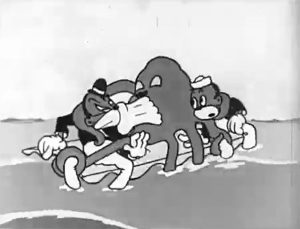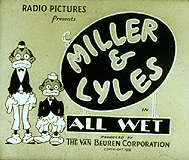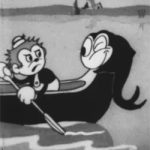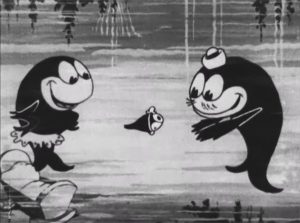To read Part 1 of this series click here; and Part 2 you can read by clicking here.
 Note: One of my research interests is going over primary source materials related to Golden Age cartoons. A very kind reader (and one who has helped others on Cartoon Research) Strummer Cash Petersen, directed me towards the copyright descriptions archived at the Library of Congress.
Note: One of my research interests is going over primary source materials related to Golden Age cartoons. A very kind reader (and one who has helped others on Cartoon Research) Strummer Cash Petersen, directed me towards the copyright descriptions archived at the Library of Congress.
Unfortunately, many cartoons, including these Tom and Jerry shorts, are under copyright. Down the road, I’m planning on visiting the LOC to read these descriptions which will provide some insights for future articles for this series.
Throughout this series, I’ve been able to identify queer coded characters, but there’s a bit of a dry spell after Pots and Pans. To hold us over until the next major occurrence in Magic Mummy, I will be examining three works from a more introspective interpretation.
The Tuba Tooter (6/4/1932, dir. John Foster and George Stallings)
The Tuba Tooter is a fantastic example of a short containing scenes a 1932 audience wouldn’t have perceived as queer, but for today’s viewer can easily be misinterpreted as queer. This leads me when watching older shorts, to go into it with two separate mindsets:
 1. Is this short portraying a queer character?
1. Is this short portraying a queer character?
2. Am I potentially misperceiving queerness due to a modern viewer bias?
In this cartoon, there are a few instances where context is important to help understand the original intention. The first occurs when Tom and Jerry initially appear in the short. The two are sharing a room in a boarding house, and are sleeping together in the same bed. Soon, they are awoken by tuba music, played by Schultz -a German immigrant who is well loved in the neighborhood- and the two rejoice and shake hands in camaraderie. There are several different reasons why the bed sharing was included, though I shall only be focusing on what is relevant to the scene. As indicated by the background design, this boarding house is far from the Ritz Hotel, with certain backgrounds showing damaged walls. Outside, the cramped, neighboring tenement buildings are also depicted. All these touches emphasize to the audience that Tom and Jerry are working class (or possibly even poorer), and reside in an immigrant neighborhood. Now, for people in Tom and Jerry’s socioeconomic bracket living during the Great Depression, two men sleeping together in a bed would be a logical, economic decision. Another reason Tom and Jerry are sharing a bed is related to composition. In this shot, Tom and Jerry are placed almost at the center of the frame. A placement which allows the eye naturally to be drawn to them. Having them sleep in separate beds not only breaks up the cohesiveness, but creates an awkward distance between the two characters. If they are too close, you might as well have them sleep in the same bed; if they are too far, they cannot easily interact with each other, and actions, such as the handshake would need to be rewritten.
 Now awake, Jerry plays the piano while Tom sings along to the song Schultz Is Back Again. Schultz joins in with his tuba, as various characters in his room celebrate, including Schultz’s dog Fritz and an unnamed, but masculine voiced cat. Later, these characters are seen holding hands in two separate scenes. This is an instance of two male characters holding hands and not supposed to be viewed as coded, with the joke focusing more on the fact that even a dog and cat are happily setting aside their differences to enjoy the festivities. I view this interaction as platonic because of how the two move and interact with one another. For instance, neither of the animals take on any of the coded characteristics expected in a Van Beuren short. I’d argue the choice to not have their hands resting on their waists was a deliberate decision to avoid any possible queer reading, and reflect the rubber hose animation from this period. Additionally, in previous Van Beuren shorts, the queer characters are quite isolated. As noted previously in Trouble and Pots and Pans, the queer characters appear in one brief gag and don’t interact with any other recurring characters in the short. In both scenes, Fritz and the cat are among a group, including their last appearance when they march alongside Tom and Jerry.
Now awake, Jerry plays the piano while Tom sings along to the song Schultz Is Back Again. Schultz joins in with his tuba, as various characters in his room celebrate, including Schultz’s dog Fritz and an unnamed, but masculine voiced cat. Later, these characters are seen holding hands in two separate scenes. This is an instance of two male characters holding hands and not supposed to be viewed as coded, with the joke focusing more on the fact that even a dog and cat are happily setting aside their differences to enjoy the festivities. I view this interaction as platonic because of how the two move and interact with one another. For instance, neither of the animals take on any of the coded characteristics expected in a Van Beuren short. I’d argue the choice to not have their hands resting on their waists was a deliberate decision to avoid any possible queer reading, and reflect the rubber hose animation from this period. Additionally, in previous Van Beuren shorts, the queer characters are quite isolated. As noted previously in Trouble and Pots and Pans, the queer characters appear in one brief gag and don’t interact with any other recurring characters in the short. In both scenes, Fritz and the cat are among a group, including their last appearance when they march alongside Tom and Jerry.
 Plane Dumb (6/25/1932, dir. John Foster and George Rufle)
Plane Dumb (6/25/1932, dir. John Foster and George Rufle)
When I examine these shorts and notice a character that is androgynously designed, one question that arises is, how important is knowing the character’s gender? While it’s not the case for every situation in a cartoon, I do feel this can impact how a character or a gag is interpreted. A somewhat androgynous character connected with a gag occurs not only in Plane Dumb but in Jolly Fish. While these situations are interesting to analyze, to be frank, this interpretive gray area provides me with a figurative (and sometimes literal) headache. Despite my choice of research, I prefer to write about canonical queer representation rather than from a theoretical interpretation. Although I won’t say I will never write about queer theory (as indicated by this month’s article), I do prefer to examine shorts that are less debatable in what type of joke is being conveyed to the audience.

This film was originally made and titled “All Wet” with the blackface vaudeville duo Miller & Lyles.
In this short, Tom and Jerry are flying a plane and have almost reached Africa. For their protection, the two don disguises in the form of blackface, which the two characters remain in for the majority of the short. David Gerstein’s summary for Plane Dumb provides some insight about the cartoon’s development. Originally, instead of Tom and Jerry, the lead characters were supposed to be the Black vaudeville comedian duo Flournoy Eakin Miller and Aubrey Lee Lyles. Over time, however, this original concept was scrapped, and turned into a Tom and Jerry short. To save money, the Miller and Lyles designs (“portrayed” by Tom and Jerry respectively) remained, with the aforementioned blackface serving as the reason why Tom and Jerry wear it for the majority of the short’s runtime.
Unfortunately, Tom loses control of the plane and the two crash into the ocean, and use a destroyed part of the plane as a raft. Although stuck at sea, Tom and Jerry still try to head to Africa. Suddenly, an octopus joins them. This character is racialized, with a dark body and exaggerated lips. While there are very few indicators, the octopus is supposed to be viewed as male. This is partly due to his masculine-sounding laugh, though it is still an inhuman sound. The octopus causes both men to react in fear. In a sudden, and awkward cut, the octopus now unexplainably has his tentacles wrapped around Tom and Jerry’s shoulders and by their knees. This sudden cut does make one wonder if, given the complicated development history of the short, more animation was supposed to be in this scene -such as the octopus wrapping his limbs on the characters- which did not make it into the final edit. Alternatively, to save money, they could have just done an animation “cheat” by doing an abrupt edit and a slightly closer shot. By having this cut, it allows the audience to fill in the blanks about the octopus’ movements. I personally feel the latter is what likely occurred.
 Tom and Jerry, now caught in the hold of the octopus, argue with one another, until the octopus interrupts them, laughs, and kisses Tom on the cheek. Afterwards, the octopus makes a face at Tom with his tongue sticking out. Tom responds by punching the octopus’ nose, which angers the octopus. He flips Tom over and punches him -which causes Tom to cry out in pain- and then spanks his behind with his tentacles. Typically, Jerry is spared from these direct physical attacks, but here he is roped into the conflict. Although the octopus primarily focuses on Tom throughout his appearance, when attacking Tom, the octopus ends up hitting Jerry in the process. After studying several of these kiss gags, it becomes noticeable how much Tom (or in this case, Miller) is put through the absolute wringer in these sequences. As is common when writing jokes, the gag keeps escalating each time it reappears. From simply trapped in a block of ice, to being forced to fight off an angry bull, and now getting spanked quite aggressively by a furious octopus.
Tom and Jerry, now caught in the hold of the octopus, argue with one another, until the octopus interrupts them, laughs, and kisses Tom on the cheek. Afterwards, the octopus makes a face at Tom with his tongue sticking out. Tom responds by punching the octopus’ nose, which angers the octopus. He flips Tom over and punches him -which causes Tom to cry out in pain- and then spanks his behind with his tentacles. Typically, Jerry is spared from these direct physical attacks, but here he is roped into the conflict. Although the octopus primarily focuses on Tom throughout his appearance, when attacking Tom, the octopus ends up hitting Jerry in the process. After studying several of these kiss gags, it becomes noticeable how much Tom (or in this case, Miller) is put through the absolute wringer in these sequences. As is common when writing jokes, the gag keeps escalating each time it reappears. From simply trapped in a block of ice, to being forced to fight off an angry bull, and now getting spanked quite aggressively by a furious octopus.
While the octopus is not drawn in a coded way, unlike previous instances of this gag, it seems a bit more unclear, and arguably so, what his exact intention is with Jerry. The humor does stem from the idea that the audience should find it funny that a male character is kissing another male character through force. For many of these kiss gags, I don’t feel the writers thought deeply about the greater implications; they simply found this type of male affection “funny.” Although “posterior humor” appears in every animation studio’s gag repertoire, it does seem a bit more pointed in this scene. I try not to overthink or focus on the greater implication of “posterior humor” in cartoons (many times I feel the joke is there because someone thought it was funny). However, because the octopus is rejected and reacts so violently towards Tom, the emphasis on the behind does not help how one can interpret the situation.
 Jolly Fish (8/19/1932, dir. John Foster and George Stallings)
Jolly Fish (8/19/1932, dir. John Foster and George Stallings)
Early in Jolly Fish, there is an androgynous fish whose design includes no clothing, no spoken lines to categorize them based on vocal range, and, besides a full set of eyelashes, no other visual indicators to clearly identify their gender to the audience. For a theorist, these identifiers allow for a queer reading. If I had to pick a gender, as suggested by Gerstein’s summary on Cartoon Research, I would say the fish is supposed to be interpreted as female. Especially since the fish is not given any distinct queer coding details, and pronounced eyelashes were commonly associated with female characters. Instead of Tom being the subject of an animal’s desire, it is now Jerry who must fend off the interested suitor. While paddling their canoe, Jerry, who is in the back, is soon followed by a fish. She hoists herself onto the canoe, directly behind Jerry. Immediately, she is smitten with him, batting her eyelashes, and licking Jerry’s face. During the fish’s flirting, the cuckoo sound effect is played several times, once again emphasizing the ridiculousness of the situation. Jerry, however, is not amused by this attention. Despite this, the fish cannot take a hint and continues to wink and abruptly grabs and pulls Jerry close to her. This is the last straw for Jerry. He slaps her off the canoe so forcefully she falls back into the water. When she returns on-screen, she is furious, running on top of the water after the canoe.

No confusion over who is the mother or the father here -I didn’t even know fish could grow facial hair!
Expanding upon the theoretical queer reading, there are several ways for animators to indicate a character’s gender. These indicators can be quite simple and done through voice, physique, and/or clothing. On average, I typically place mute, androgynous, and unclothed characters into the “male” category. This is due to the binary view on gender during this period, the dominance of male characters depicted on-screen, and the fact that most of the people working on these shorts were male. Going by this theory that ambiguously designed characters are more likely to be read as male, why shouldn’t one automatically assume this fish is supposed to be interpreted as male? Now, I personally do not consider this gag as trying to depict a queer character. As previously examined in this series, Van Beuren has certain queer coding preferences, which the fish doesn’t fit. However, the studio did have character design outliers, the Magic Mummy is one such example, and a short which I will delve into more next month.
Later in Jolly Fish, a male and female fish appear with their child, which presents more questions than answers. Why are these two distinctly gendered, when the fish pursuing Jerry wasn’t? Ultimately, this is purely speculative, and the scene with Jerry and the fish is simply a long gag sequence. However, the fish’s gender would impact how the gag is supposed to be interpreted. I find her design interesting; she easily could have been given clothing in the form of a skirt or hat, but instead, she is presented as a blank slate, allowing a viewer to project their own opinion on how to consider the character.




































It’s not uncommon for male cartoon characters to share a bed once in a while, for example Gandy Goose and Sourpuss, or Yogi Bear and Boo Boo — all of whom, at one point or another, were shown to have female love interests, which is more than you can say for Tom and Jerry.
What caught my eye in “The Tuba Tooter” was the dancing scene about five minutes in. We see the back of a bald man in a black shirt and derby hat, whose dancing partner is wearing a Tirolean hat with a ribbon and apparently has either very short hair or none at all. It looks for all the world like two men dancing together. However, when you examine the scene VERY closely frame by frame, it seems that the dancing partner is wearing a grey skirt with dark stockings or hose. That doesn’t necessarily rule out the possibility that the dancing partner could be male, but given that all the other dancing couples in the scene are mixed, it seems unlikely.
Now, the way you tell a male octopus apart from a female one is, the male octopus has a specially modified tentacle called a hectocotylus that is used for transferring spermatophores to the mantle of the female. The octopus in “Plane Dumb” lacks a hectocotylus, ergo, it must be a female. Q.E.D. However, I strongly doubt that any of the Van Beuren animators were cognizant of the finer points of cephalopod anatomy. After all, the octopus in “Jolly Fish” has twelve arms, none of them hectocotyli, which I suppose would make it a female dodecapus.
Presumably non-sexual bed sharing was fairly common in live action films, perhaps reflecting reality for 30s audiences. Laurel and Hardy often slept — or tried to sleep — in the same bed, in boarding houses and Pullman cars. The Three Stooges would occasionally crowd onto a single mattress, although their preferred repose seemed to be a triple-decker bunk bed, shakily built. Men were often shown sharing a bed in hotels, usually set up as the result of short funds or limited vacancies. A common comic setup was one or more parties getting drunk and collapsing into a wrong bed, occupied by a sleeping member of the opposite sex. Single girls — struggling dancers, shopgirls, stenos, etc. — frequently doubled up, an excuse to do exposition and wisecracks in lingerie.
The couple that interests me in THE TUBA TOOTER are the chorus girls in their scanties.
I think Plane Dumb is the most bizarre repurposing that I’ve heard of. I’ve heard of retrofitting backdoor pilots into TV shows, but something about the decision to suddenly backpedal onto existing characters in this situation confounds me. Were VB Tom and Jerry just that much more marketable?
An issue over copyrights, more likely. About seeing the Tuba Tooter under this light, I think it should be mentioned the morphing of the tuba horn when is being played. A very clever trick, Mr. Van Beuren!
You didn’t know fish could grow facial hair?
Obviously you’ve never heard of catfish whiskers.😁
Sorry for the bad joke,but it’s early here.
Thank you!
I very much appreciate your thoughtful and nuanced take on these shorts.
It is always easier to see through today’s cultural eyeglasses and make broad or dismissive statements about materials from the past — but you have done the more difficult work of considering the many cultural layers at play.
I agree that sometimes a gag’s primary reason for existing is that “someone thought it was funny.” Reminds me of Freud’s statement that “Sometimes a cigar is just a cigar.”
Thank you!